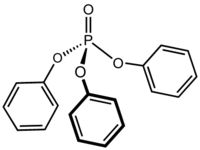Triphenyl phosphate
 |
|
 |
|
| Names | |
|---|---|
|
IUPAC name
Triphenyl phosphate
|
|
| Identifiers | |
|
3D model (Jmol)
|
|
| ChEBI | |
| ChemSpider | |
| ECHA InfoCard | 100.003.739 |
|
PubChem CID
|
|
|
|
|
|
| Properties | |
| C18H15O4P | |
| Molar mass | 326.29 g·mol−1 |
| Appearance | Colorless solid |
| Density | 1.184 g/mL |
| Melting point | 48 to 50 °C (118 to 122 °F; 321 to 323 K) |
| Boiling point | 244 °C (471 °F; 517 K) at 10 mmHg |
| Vapor pressure | 1 mmHg (193 °C) |
| Hazards | |
| Main hazards | Harmful |
| Flash point | 220 °C (428 °F; 493 K) |
| Lethal dose or concentration (LD, LC): | |
|
LD50 (median dose)
|
1320 mg/kg (mouse, oral) 3500 mg/kg (rat, oral) |
| US health exposure limits (NIOSH): | |
|
PEL (Permissible)
|
TWA 3 mg/m3 |
|
REL (Recommended)
|
TWA 3 mg/m3 |
|
IDLH (Immediate danger)
|
1000 mg/m3 |
|
Except where otherwise noted, data are given for materials in their standard state (at 25 °C [77 °F], 100 kPa).
|
|
|
|
|
| Infobox references | |
Triphenyl phosphate (TPhP) is the chemical compound with the formula OP(OC6H5)3. This colourless solid is the ester (triester) of phosphoric acid and phenol. It is used as a plasticizer and a fire retardant in a wide variety of settings and products.
Triphenyl phosphate is prepared by the reaction of phosphorus oxychloride and phenol:
Triphenyl phosphate has been used widely as a flame retardant and plasticizer. It has been used as a flame retardant for a variety of materials, including electronic equipment, PVC, hydraulic fluids, glues, and casting resins. Its mechanism of action as a flame retardant is as follows: first, during thermal decomposition, phosphoric acid is formed. This reacts to form pyrophosphoric acid, which, when in its condensed phase, acts to block heat transfer. One of the most effective flame retardants for certain polymers, TPhP is only active as an additive flame retardant in its gas phase. Phase out of PBDEs may have increased the use of TPhP in recent years.
TPhP is also used as a plasticizer in lacquers, varnishes, and hydraulic fluids. Nail polish has received particular interest as a source of exposure to TPhP.
Limited information is available indicating significant toxicological effects of TPhP. Although it was initially expected to have an overall low impact, a growing body of evidence suggests that the effects may not be so harmless. Triphenyl phosphate exhibits low acute toxicity by dermal or oral contact. However, an increasing number of studies have linked exposure to TPhP with reproductive and developmental toxicity, neurotoxicity, metabolic disruption, endocrine effects, and genotoxicity. TPhP has also been found to induce significant estrogenic activity. One study found that concentrations above the lowest observable effect level have been observed in a variety of other studies in coral grouper, yellow striped goat fish, and freshwater perch. This indicates that TPhP may be present in the environment at high enough concentrations to have harmful ecological effects. The European Chemicals agency considers TPhP to be "very toxic" to aquatic life, with potentially long-lasting effects.
...
Wikipedia
